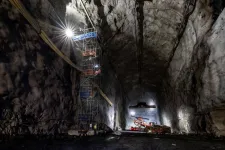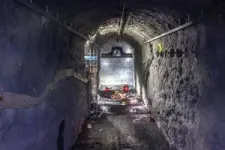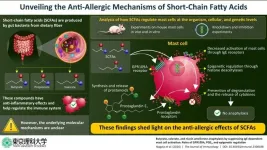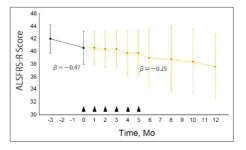(Press-News.org) Excavation workers have finished carving out the future home of the gigantic particle detectors for the international Deep Underground Neutrino Experiment. Located a mile below the surface, the three colossal caverns are at the core of a new research facility that spans an underground area about the size of eight soccer fields.
Hosted by the U.S. Department of Energy’s Fermi National Accelerator Laboratory, DUNE scientists will study the behavior of mysterious particles known as neutrinos to solve some of the biggest questions about our universe. Why is our universe composed of matter? How does an exploding star create a black hole? Are neutrinos connected to dark matter or other undiscovered particles?
The caverns provide space for four large neutrino detectors—each one about the size of a seven-story building (see 2-minute animation). The detectors will be filled with liquid argon and record the rare interaction of neutrinos with the transparent liquid.
Trillions of neutrinos travel through our bodies each second without us even knowing it. With DUNE, scientists will look for neutrinos from exploding stars and examine the behavior of a beam of neutrinos produced at Fermilab, located near Chicago, about 800 miles east of the underground caverns. The beam, produced by the world’s most intense neutrino source, will travel straight through earth and rock from Fermilab to the DUNE detectors in South Dakota. No tunnel is necessary for the neutrinos’ path.
“The completion of the excavation of these enormous caverns is a significant achievement for this project,” said U.S. Project Director Chris Mossey. “Completing this step prepares the project for installation of the detectors starting later this year and brings us a step closer towards fulfilling the vision of making this world-class underground facility a reality.”
Engineering, construction and excavation teams have been working 4,850 feet below the surface since 2021 at the Sanford Underground Research Facility, home of the South Dakota portion of DUNE. Construction crews dismantled heavy mining equipment and, piece by piece, transported it underground using an existing shaft. Underground, workers reassembled the equipment, and workers spent almost two years blasting and removing rock. Close to 800,000 tons of rock were excavated and transported from underground into an expansive former mining area above ground known as the Open Cut.
Workers will soon begin to outfit the caverns with the systems needed for the installation of the DUNE detectors and the daily operations of the research facility. Later this year, the project team plans to begin the installation of the insulated steel structure that will hold the first neutrino detector. The goal is to have the first detector operational before the end of 2028.
“The completion of the three large caverns and all of the interconnecting drifts marks the end of a really big dig. The excavation contractor maintained an exemplary safety record working over a million hours without a lost-time accident. That's a major achievement in this heavy construction industry,” said Fermilab’s Michael Gemelli, who managed the excavation of the caverns by Thyssen Mining. “The success of this phase of the project can be attributed to the safe, dedicated work of the excavation workers, the multi-disciplined backgrounds of the project engineers and support personnel. What a remarkable achievement and milestone for this international project."
DUNE scientists are eager to start the installation of the particle detectors. The DUNE collaboration, which includes more than 1,400 scientists and engineers from over 200 institutions in 36 countries, has successfully tested the technology and assembly process for the first detector. Mass production of its components has begun. Testing of the technologies underlying both detectors is underway using particle beams at the European laboratory CERN.
Fermilab is America’s premier national laboratory for particle physics and accelerator research. A U.S. Department of Energy Office of Science laboratory, Fermilab is located near Chicago, Illinois, and operated under contract by the Fermi Research Alliance LLC. Visit Fermilab’s website at www.fnal.gov and follow us on Twitter at @Fermilab.
The DOE Office of Science is the single largest supporter of basic research in the physical sciences in the United States and is working to address some of the most pressing challenges of our time. For more information, please visit science.energy.gov.
END
Excavation of colossal caverns for Fermilab’s DUNE experiment completed
2024-02-01
ELSE PRESS RELEASES FROM THIS DATE:
BIPOC individuals bear greater post-COVID health burdens, new research suggests
2024-02-01
Black, indigenous, and people of color (BIPOC) who were infected with COVID-19 experienced greater negative aftereffects in health and work loss than did similarly infected white participants, new research finds.
Despite similar symptom prevalence, BIPOC and Hispanic patients experienced greater negative impacts on their health status, activity levels, and ability to work compared with non-Hispanic and white patients participating in the ongoing multi-site INSPIRE clinical trial examining people with long COVID.
The findings are published in the journal Frontiers ...
National Academy of Medicine member new president of The Obesity Society
2024-02-01
ROCKVILLE, Md. — A member of the National Academy of Medicine is the new president of The Obesity Society (TOS), the organization announced today.
Jamy Ard, MD, FTOS, is professor in the Departments of Epidemiology and Prevention and Internal Medicine and vice dean of Clinical Research at Wake Forest University School of Medicine in Winston-Salem, N.C. He also co-directs the Atrium Health Wake Forest Baptist Weight Management Center, where he oversees medical weight management programs.
“I am honored to serve as president of ...
How to run a password update campaign efficiently and with minimal IT costs
2024-02-01
Updating passwords for all users of a company or institution’s internal computer systems is stressful and disruptive to both users and IT professionals. Many studies have looked at user struggles and password best practices. But very little research has been done to determine how a password update campaign can be conducted most efficiently and with minimal IT costs. Until now.
A team of computer scientists at the University of California San Diego partnered with the campus’ Information Technology Services to analyze the messaging for a campuswide mandatory ...
Five advances that could change heart health monitoring
2024-02-01
Chocolate valentines and candies with sweet sayings shouldn't be the only hearts you think about this February. It’s also American Heart Month, which puts a spotlight on cardiovascular health. According to the American Heart Association, heart disease is the leading cause of death for Americans, so it’s important to know the status of your own heart health. New methods for cardiac monitoring can be found in these five papers recently published in ACS journals. Reporters can request free access to these papers by emailing newsroom@acs.org.
Future ...
Gut bacteria can process dietary fiber into an anti-allergy weapon, finds new study
2024-02-01
The intricate relationship that exists between humans and the gut microbiome has become a hot research topic, and scientists are constantly uncovering new reasons why a healthy diet can lead to a healthier life. Dietary fibers are a particularly important aspect of this connection. When we ingest these compounds, which are mainly found in plant-based foods, our gut bacteria break them down into small molecules, called short-chain fatty acids (SCFAs). Over the past few years, studies have revealed various important anti-inflammatory and immunomodulating effects of SCFAs.
One of the ways SCFAs interact with ...
Insights from a phase II clinical trial with CL2020 Muse cell-based therapeutic for Amyotrophic lateral sclerosis
2024-02-01
Amyotrophic lateral sclerosis (ALS) is a neurodegenerative disease characterized by progressive loss of motor functions, which eventually leads to death within 5 years of its onset. This disease causes weakness and atrophy of limbs and other muscles, which affect mobility speech, eating, and even breathing in patients. Some drugs, including riluzole, edaravone, and sodium phenylbutyrate/taurursodiol are used for treating ALS, but with limited therapeutic benefits. Therefore, novel, effective ALS treatments are the need of the hour.
Multilineage-differentiating stress-enduring (Muse) cells are pluripotent stem cells ...
Increased temperature difference between day and night can affect all life on earth
2024-02-01
Researchers from Chalmers University of Technology, in Sweden, have discovered a change in what scientists already knew about global warming dynamics. It had been widely accepted since the 1950s that global temperature rises were not consistent throughout the day and night, with greater nighttime warming being observed. However, the recent study reveals a shift in dynamics: with greater daytime warming taking place since the 1990s. This shift means that the temperature difference between day and night is widening, potentially affecting all life on Earth.
The ...
Rice research unveils key dynamics of 2D nanomaterials with view to larger-scale production
2024-02-01
HOUSTON – (Feb. 1, 2024) – A team of Rice University researchers mapped out how flecks of 2D materials move in liquid ⎯ knowledge that could help scientists assemble macroscopic-scale materials with the same useful properties as their 2D counterparts.
“Two-dimensional nanomaterials are extremely thin ⎯ only several atoms thick ⎯ sheet-shaped materials,” said Utana Umezaki, a Rice graduate student who is a lead author on a study published in ACS Nano. “They behave very differently from materials we’re used to in daily life and can have really useful properties: They can withstand a lot of ...
CT scan is most effective to assess people with chest pain
2024-02-01
Previous studies have found less than 40% of patients with stable chest pain undergoing invasive coronary angiography are found to have obstructive coronary artery disease. Recent randomized clinical trials have demonstrated a benefit to using computed tomography angiography (CTA) first in evaluation of these patients, and a new study being presented at the American College of Cardiology Cardiovascular Summit lends credence to this strategy, finding that CT was associated with a higher likelihood of revascularization compared to other imaging modalities or no testing.
Stable angina ...
UMass Chan advances research into long COVID, chronic fatigue syndrome
2024-02-01
A study led by UMass Chan Medical School viral immunologists Liisa Selin, MD, PhD, and Anna Gil, PhD, discovered similarities in immune system dysfunction as a potential biomarker among people living with long COVID and myalgic encephalomyelitis/chronic fatigue syndrome (ME/CFS). The research also introduced a novel treatment and a method to track effective treatment interventions. The research was published online in Brain, Behavior & Immunity.
Dr. Selin, professor of pathology, ...






